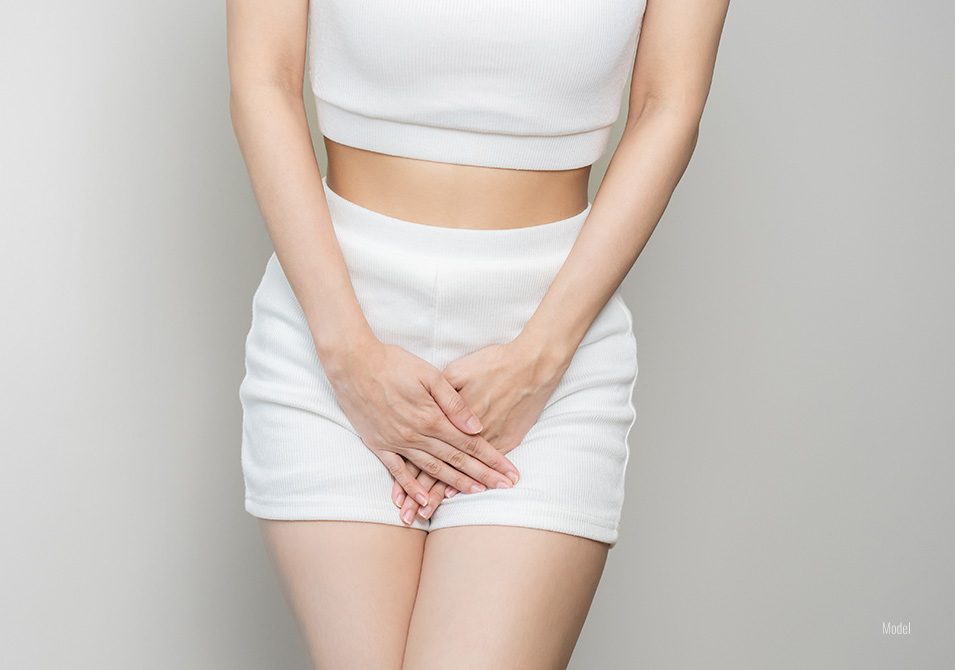What Is Causing My Urinary Incontinence?
Posted May 23, 2024 in Urinary Incontinence

Urinary incontinence is a frustrating issue that interferes with the rhythm of your daily life. There are a variety of bladder conditions that can lead to urinary leakage and urgency issues. This blog will review these causes, how to evaluate symptoms, and what their doctor can do about it.
4 Min Read:
What Is Urinary Incontinence?
When you gotta go, it’s panic-inducing not to be able to reach a bathroom. Experiencing a loss of control over your bladder is frustrating and embarrassing. Urinary incontinence (UI) can manifest in many forms, such as leaking urine when you cough or having a sudden urge to urinate without getting to a toilet in time.
Despite the inconvenience of this issue, chronic or temporary urinary incontinence is rather common, with millions of women reporting issues with UI at least monthly. It is more common in women over the age of 50, but it is by no means a condition a person must suffer through as a normal part of aging.
What Are the Different Types of Incontinence?
Loss of bladder control or urinary leakage is a seemingly straightforward issue with a variety of possible causes. Your UI may be a combination of the types outlined below.
Stress Incontinence
This type of UI is caused by movements that put pressure on the bladder, such as laughing, coughing, sneezing, or physical exertion, like lifting heavy objects.
Urge or Urgency Incontinence
If you struggle to hold your urine long enough to make it to the toilet, you may have urge incontinence. This type of incontinence is often accompanied by the need to urinate frequently or a strong, sudden urge to urinate. Some women report leaking urine on their way to the restroom. Urge incontinence is sometimes related to another disease or condition, such as infection, diabetes, or a neurological disorder.
Overflow Incontinence
This occurs when the bladder is over-filled with urine and cannot empty completely, resulting in frequent or constant leakage.
Functional Incontinence
When a physical condition, such as arthritis or injury, impairs your ability to reach a restroom in time, this is known as functional incontinence. For example, a person with arthritis may struggle to unbutton their pants quickly enough.
Mixed Incontinence
Many people experience two or more types of incontinence. Mixed incontinence usually refers to the combination of stress and urge incontinence.
Fistula
The vaginal canal and urethra or urinary tract are two separate tubes. Still, sometimes there can be an abnormal opening between the two, causing urine to leak out from the bladder, into the vaginal canal, and travel out of the body. A fistula can be caused by injury, surgery, infection, and other complications. This condition must be treated, as it does not heal independently.
Diverticulum
A urethral diverticulum occurs when a pocket forms along the wall of the urethra, which can fill with urine or pus. A diverticulum can leak out collected urine at inopportune times and may even cause infection.
Overactive Bladder
This refers to a collection of symptoms, including a sudden, strong urge to urinate (urinary urgency) and urinating more than eight times a day (urinary frequency). Overactive bladder (OAB) is somewhat common in adult men and women.
How Is Urinary Continence Diagnosed?
There are a few steps to evaluating and diagnosing incontinence. A basic outline of the process is as follows:
- Make an incontinence evaluation appointment.
- Come prepared with information about your health and medical history.
- Keep a daily record of your bladder function and beverage intake.
- Undergo bladder tests:
- Bladder Stress Test: You cough while your physician checks for urine leakage.
- Post-Void Residual Test: A catheter measures the quantity of urine left in the bladder after urination.
- Urinalysis: A urine test may be performed to check for infection or other issues.
- Blood Test: This can help determine other potential causes of UI.
How Is Urinary Incontinence Treated?
Depending on the results of your diagnosis, several treatment options are available.
Treatment for stress incontinence may involve strengthening the pelvic floor through Kegel exercises. Vaginal pessaries are another option—a pessary is a plastic device that provides support to prolapsed pelvic organs. Finally, surgery is a highly effective solution if deemed appropriate.
Urge incontinence treatment involves retraining the bladder to hold more urine and to adhere to a bathroom schedule. This treatment may involve diet modifications, like avoiding caffeine and other bladder irritants. Finally, medications may provide a helpful boost to a treatment plan.
Overactive bladders can be treated in various ways, including bathroom scheduling, bladder training, and Kegel exercises. Drug therapy and neuromodulation are other options available.
Interested in Urinary Incontinence Treatment in Santa Rosa?
It’s important to understand that urinary incontinence is not an inevitable part of aging. There’s no need to feel embarrassed or to suffer in silence. This is a treatable condition. Fill out our online contact form or call us today at (707) 575-1626 to schedule a consultation. We’re here to help and look forward to hearing from you!